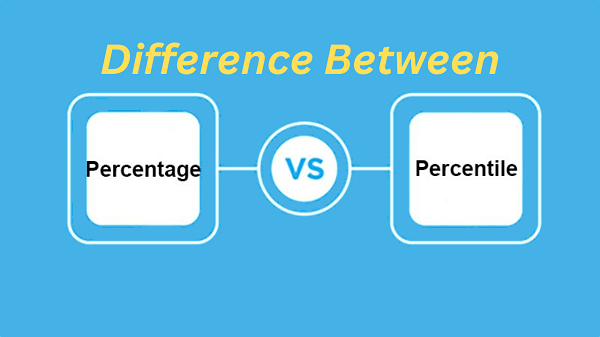Difference between Percentage and PercentileWhat does a percentage mean?Latin gave us the word percentage, which means "out of one hundred." Therefore, 50% represents 50 out of every 100. Percentages offer a convenient approach to normalising various values for comparison. Calculations are made simpler by using percentages. Working with parts of 100 is notably easier than working with thirds, twelfths, and other fractions, especially since many fractions lack an error-free decimal counterpart. For example, a student has earned an aggregate grade of 55% in math, if he receives 55 out of a possible 100 marks in that subject. 
What does a percentile mean?Most often, a percentile can be defined as a figure below which is a predetermined proportion of scores fall. A relative standing statistic known as a percentile is what you need if you wish to figure out where you are in relation to the other members of the group. For instance, if you are indeed the fourth tallest guy within a group of 20. 80% of people seem to be shorter than you. You are thus in the 80th percentile. Importance of Percentage:
Importance of Percentile:
Usage of Percentage:Numerous scenarios make frequent use of percentages. Percentages are used to communicate a variety of media facts, including retail discounts, rates of interest, inflation rates, and more. For understanding the financial elements of daily life, percentages are a key element. For non-mathematicians, expressing changes in observable elements such as sales, loss, market dominance, and take rate using percentages is a straightforward way to do so. You must perform some fundamental mathematics in order to compute and use apercentage. Additionally, you'll want at least two numbers that express the same concept, like the overall quantity of units sold throughout the course of the initial and later years. Usage of Percentile:The presented data is understood and interpreted using percentiles. The parameters below which a specific proportion of data in a data collection are discovered are also shown. When interpreting test results and biometric measures in our daily lives, percentiles are usually helpful. Key Distinctions between Percentage and PercentileA mathematical number that may be stated as a fraction with a denominator of 100 is referred to as a percentage. On the contrary, a percentile is a place at or below which a particular proportion of measurements fall and is measured along the scale of the displayed variable. Percentage represents scores out of 100, per 100, or for every 100. On the other hand, percentile denotes rank based on the comparison of one case with several cases. While percentile denotes a person's place or status, percentage displays a rate, quantity, or amount. When a percentage isexpressed, the sign "%,"which indicates "division by 100," is employed. The percentile, in contrast, is represented by the symbol pth, where p is a numeral. In contrast to the percentile, which is based on relative analysis or score, the percentage is dependent on a person's performance or score. When using a percentage, the difference between the actual and total scores is compared. In contrast, a pupil's percentile rank is compared to the entire number of pupils who took the exam. When the denominator is 100, the percentage is employed to show fractional amounts as whole numbers. In contrast, the percentile serves to show how the results compare to other scores. Due to the dataset being split into 100 equal pieces, the percentile contains quartiles, However, the percentage does not. The percentage is not based on the normal frequency distribution, although the percentile is. ConclusionSince the base value is always 100, the percentage is primarily used to convey data as well as to demonstratethe comparison. However, at the other hand, the percentile is mostly used in ranking systems since it allows us to find out the relative status of a value.
Next TopicDifference between
|
 For Videos Join Our Youtube Channel: Join Now
For Videos Join Our Youtube Channel: Join Now
Feedback
- Send your Feedback to [email protected]
Help Others, Please Share










